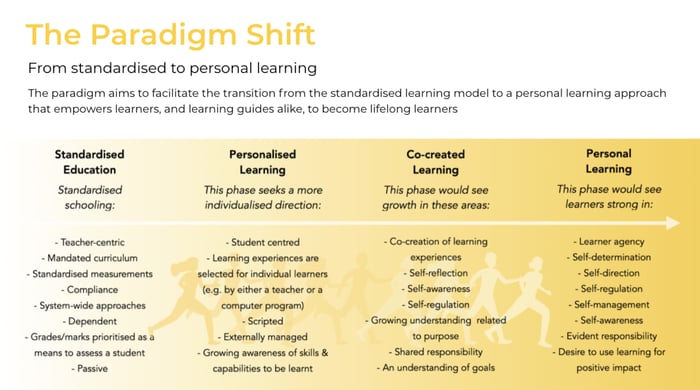When I was at school - particularly during my teenage years - there was an internal narrative that repeatedly entered my psyche which I imagine many people might relate to. It went something along the lines of, ‘I cannot wait to leave school so I don’t have to learn anymore.’
Thankfully with hindsight, I have managed to make peace with my rebellious self, but it took years to fully acknowledge the impact that traditional learning had on me. I can’t help but reflect on what my experiences might have been like had learning been more personal and meaningful to me - something that all individuals would likely find much more empowering and motivating than the existing system which continues to narrow learning opportunities to suit those who thrive in rote learning models or those with a propensity towards mundane, repetitive tasks.
Conforming to traditional methods and the lack of personal learning
I recall at the beginning of my Primary 3 (age 6/7) noticing a difference in teaching style from the previous year; by this stage most of our learning occurred sitting behind a desk. Forget about play; that was for Kindergarten and Primary 1 and 2 learners, and we were big boys and girls now. Primary 3 was also the year in my culture where testing became part of the norm and I recall sensing the emerging hierarchy forming among my peers. Expectations - be they high or low - locked individuals into groups where they became labelled according to ability and behaviour. And we all knew our place in this perverse system. I would count up the number of years of tests I had left to sit before I was free - the many years ahead seemed bleak to a six year old!
As those years rolled on, and the repetitive conveyor belt of learning ensued, burnout, disengagement, disinterest and detachment increased within me more and more. I was so bored! I would prefer to spend my time during most classes staring out the window and while I acknowledge the flaw in my own character for this seemingly low attention span, I will argue the point that research does show individuals disengage from listening after seven minutes of continuous talking. It is likely that politeness and a conformist culture played a huge part in the passive listen-to-learn model that pervasively embeds itself in many learning communities and cultures around the world, like crawling ivy choking the very bricks and mortar of learning itself. And of course there were those learners labelled ‘badly behaved’ because they could not conform to sitting and listening for long periods of time; but why should they?
Emerging from school I wrestled with some existential questions; was there something wrong with me? Why did I not want to learn? Why was I so bored? Was I different? I inherited negative associations with learning long after I had left.
Shifting community mindsets and expectations towards personal learning
Fast-forward some years after leaving school and would you believe the great irony - you may have guessed - I became a teacher! I entered into the system as an elementary practitioner, acknowledging its flaws and determined to make a positive change. While I did my best to provide a learning environment that offered learners the opportunity to learn in a variety of ways and even empower them to design their own learning when possible, the stranglehold of standardised assessment forced my hand out of continuing to work in a job that I grew to love (the kids, the connections, the community) but ultimately felt disenfranchised by because I felt I was failing the kids - this time as an educator.
During my years of professional practice, I came to empathise more - and still do - with the pressure teachers face in delivering the same content to learners of varied abilities and interests through mandated curricula. It is this very pressure that calls into question whether schools do kill creativity and remove the fun from learning. And as we enter into what I sense is a new era and narrative for learning, I feel that the most important thing we can offer emerging generations of young learners is communities where they are placed at the centre of their own learning, and where educators can become facilitators in the truest sense of the word; free to coach and guide learners on their own uniquely designed personal learning paths free from the constraints of a standardised assessment model that is no longer fit for purpose. This is personal learning, which we at Learnlife advocate for and believe the world is ready for it.
What does personal learning look like?
Probably the most important change required to make learning personal is to move from a control mindset - where learning is passive and done to you, decided by a curriculum and educator - towards an empowerment mindset - where the learner is given agency over their own learning, equipped with the skills and competencies to design and guide themselves, supported by their peers and educators; something truly personal. The visual below depicts this transformational journey:

Shifting to personal learning requires moving learners from the principles of pedagogy (essentially learning done to the learner), to andragogy (learning co-designed with the educator), and towards heutagogy (essentially learning designed by the learner). And while not all learners will be ready to embark on their own personal learning journey right away, self-determined learning (heutagogy) must become the aspirational north star for all learners so that when they do leave formal education, they have had sufficient opportunities to develop the skills and competencies to continue on their own lifelong learning trajectory.
Static, content-heavy curricula are no longer relevant in a world of unprecedented changes where to thrive we must have the skills and competencies to cope with complexity. In a community committed to personal learning, the educator is no longer the purveyor of all knowledge, but part of a complex network which supports itself by first and foremost acknowledging we are all learners. Educators are available to coach, guide, mentor and facilitate learning when needed but learners also assume a similar role among their peers. In this learning complex, collaboration can generate high impact and community can really come alive through the use of agile, adaptive groups which form to provide learning support when needed. The greatest asset a learning community has is its collective intelligence and it must be utilised so that everyone can support and be supported too. In this sense, the community becomes the curriculum.
Personal learning does not abandon content, but places priority on the acquisition of skills and competencies. Content becomes the by-product of learning and ideally learners are able to choose whatever content they wish to engage in to support their learning. By doing so, intrinsic and extrinsic motivations to learn are much more easily garnered.
A recipe for personal learning
What - in summary - do learners need to support them on their personal learning journey?
- Autonomy and decision-making over what they want to learn and how they want to learn it.
- Autonomy and decision-making over how they provide learning outputs.
- Opportunities to learn at their own pace, honouring Vygotsky’s ZPD concept.
- Engagement WITH content - not to simply memorise and regurgitate it.
- Exposure to a variety of learning styles (VAK) and learning methodologies to broaden their toolkit of skills and learning opportunities.
- Development of metacognition skills (learning how to learn).
- Development of emotional regulation.
- Development of the skills of self-reflection.
- Competence in delivering and receiving useful feedback.
- An inclusive, collaborative learning network of support.
- Support from their educators and peers.
- Trust and guidance from their educators.
The 21st century is ready for a new learning narrative - one where the on-demand culture that our learners are growing up in is met with a learning culture that suits them; for Learnlife personal learning is the answer. Today lifelong learning is considered a prerequisite for success and leaving formal education disengaged is no longer an option if individuals are to keep up.
The ultimate aim in personal learning is for each individual to leave formal education still motivated and awed sufficiently to want to learn and my hope is that when learners do leave their formal years, their internal narrative might be something along the lines of, ‘I cannot wait to leave school equipped with the competencies and skills to continue to learn and thrive throughout my life.’
It’s time to make learning personal!
If you are interested in reading more about personal learning, please sign up to our Learnlife Alliance to access all 21 of our Elements of Learning Innovation. Our Element 8, Personal Learning & Adaptive Grouping provides further conceptual thinking related to this blog.


